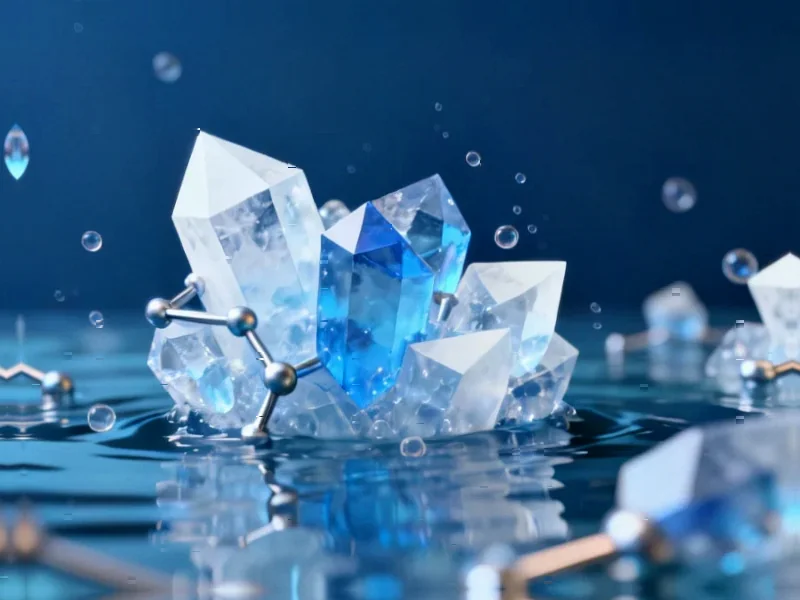According to Nature, researchers have achieved a 20-fold enhancement of nonlinear optical effects in the extreme ultraviolet (XUV) spectrum using aluminum thin films. The breakthrough leverages epsilon-near-zero (ENZ) conditions in aluminum to enable strong self-phase modulation at remarkably low intensities, potentially enabling tabletop experiments that previously required massive free-electron laser facilities. This development represents a significant advancement in our ability to manipulate light-matter interactions at the most fundamental scales.
Table of Contents
Understanding the Physics Behind the Breakthrough
The key innovation here involves exploiting what’s known as the epsilon-near-zero condition in aluminum, where the material’s dielectric permittivity approaches zero. When light interacts with matter under these specific conditions, extraordinary things happen – the phase velocity of light approaches infinity while the wavelength inside the material becomes extremely long. This creates a unique environment where nonlinear optical effects, which are typically very weak, become dramatically enhanced. The researchers cleverly used aluminum’s natural properties in the extreme ultraviolet range, where it naturally exhibits these ENZ characteristics without requiring complex metamaterial engineering.
What makes this particularly sophisticated is the use of incidence angle tuning to achieve what’s called a Fabry-Perot resonance condition. By precisely controlling the angle at which light strikes the aluminum foil, researchers can trap radiation within the material, allowing it to interact more strongly with the electrons. This approach is fundamentally different from previous ENZ research that focused on materials like indium tin oxide at their plasma frequency, as aluminum provides broadband ENZ behavior across a wide spectral range from 25 to 85 nanometers.
Critical Analysis of Technical Challenges
While the results are impressive, several significant challenges remain before this technology can achieve widespread adoption. The requirement for precise angular alignment – where even slight deviations from the optimal incidence vector can dramatically reduce the enhancement effect – presents substantial practical difficulties for real-world applications. Manufacturing aluminum foils with the required 300nm thickness and consistent optical properties at scale will require advanced fabrication techniques that may prove costly and technically demanding.
Another critical limitation involves the saturation effects observed at higher intensities. The nonlinear enhancement doesn’t scale linearly with input power, meaning researchers can’t simply increase laser power to get stronger effects. This saturation behavior, caused by electron-phonon scattering processes, fundamentally limits the maximum achievable nonlinear response. Additionally, the current experiments rely on specialized facilities like the FERMI free-electron laser, and translating these results to tabletop high-harmonic generation systems will require overcoming significant intensity and stability challenges.
Broader Scientific and Industrial Implications
This breakthrough has profound implications for multiple scientific domains. In attosecond science, the ability to generate and control nonlinear effects in the XUV regime could enable new types of pump-probe experiments with unprecedented temporal resolution. Researchers could study electron dynamics in materials with femtosecond precision, watching chemical bonds form and break in real time. For materials science, this technology provides a new window into understanding how materials behave under extreme nonequilibrium conditions.
The potential integration with high-harmonic generation systems represents perhaps the most immediate practical application. If successful, this could democratize access to advanced XUV nonlinear optics, moving these capabilities from billion-dollar facilities to university laboratories. This would accelerate research in quantum materials, catalytic processes, and fundamental light-matter interactions. The ability to perform advanced spectroscopic measurements with tabletop systems could revolutionize how we characterize novel materials and study ultrafast processes in chemistry and biology.
Future Development Pathways
The most promising near-term development will likely involve optimizing aluminum foil fabrication and exploring alternative ENZ materials that might offer better performance or easier manufacturing. Researchers will need to address the angular sensitivity issue, potentially through advanced nanostructuring or multilayer designs that provide broader angular acceptance. The integration with high-harmonic generation sources represents the critical next step – success here would validate the technology’s practical utility beyond specialized facilities.
Longer term, we can expect to see exploration of second-order nonlinear effects in engineered non-centrosymmetric aluminum structures, which could open entirely new application spaces. The combination of ENZ enhancement with other nanophotonic approaches could lead to integrated nonlinear optical devices operating across the UV to XUV spectrum. However, significant engineering challenges around thermal management, damage thresholds, and fabrication precision must be overcome before commercial applications become feasible. The next 2-3 years will be crucial for determining whether this laboratory demonstration can evolve into a practical technology platform.



